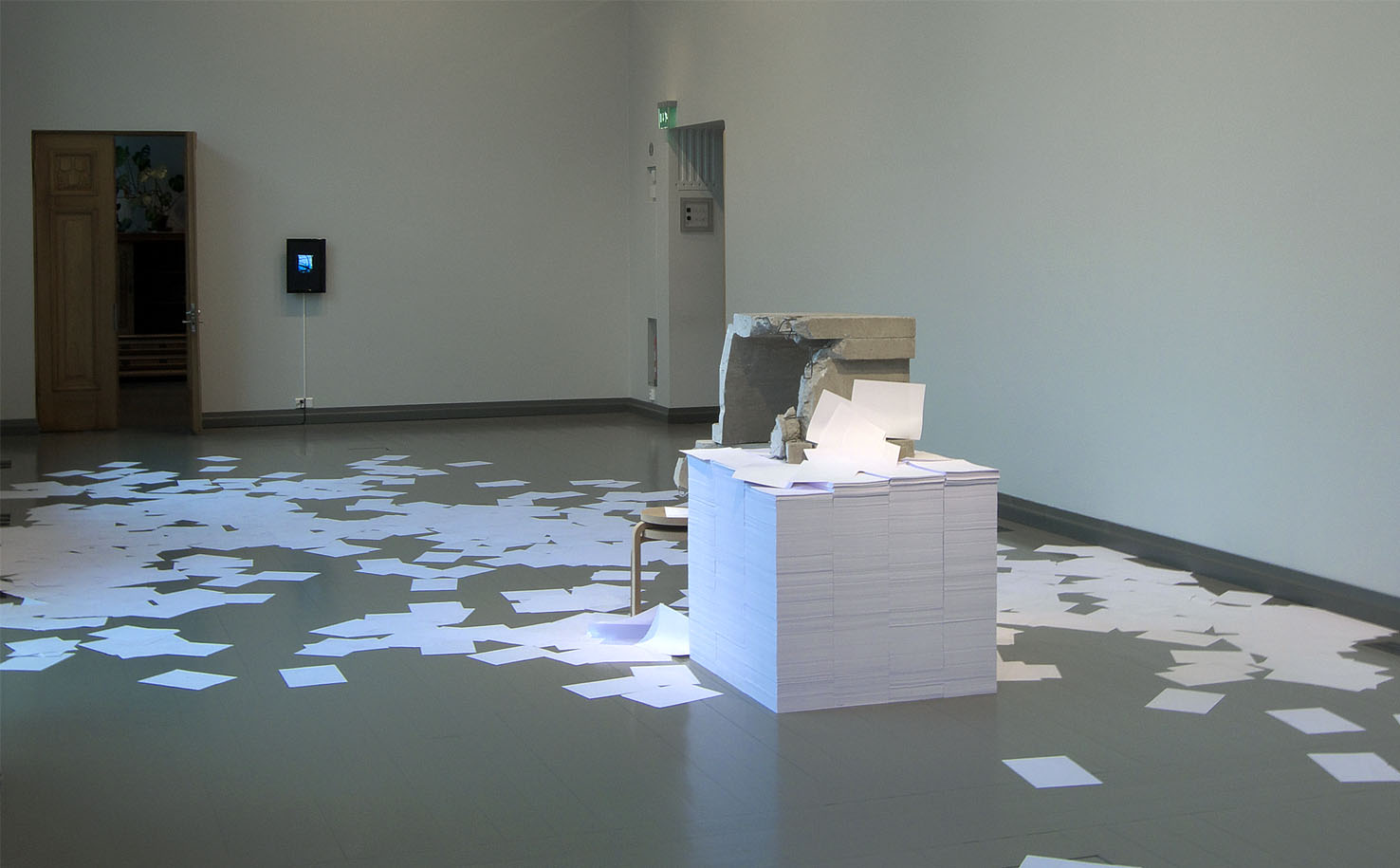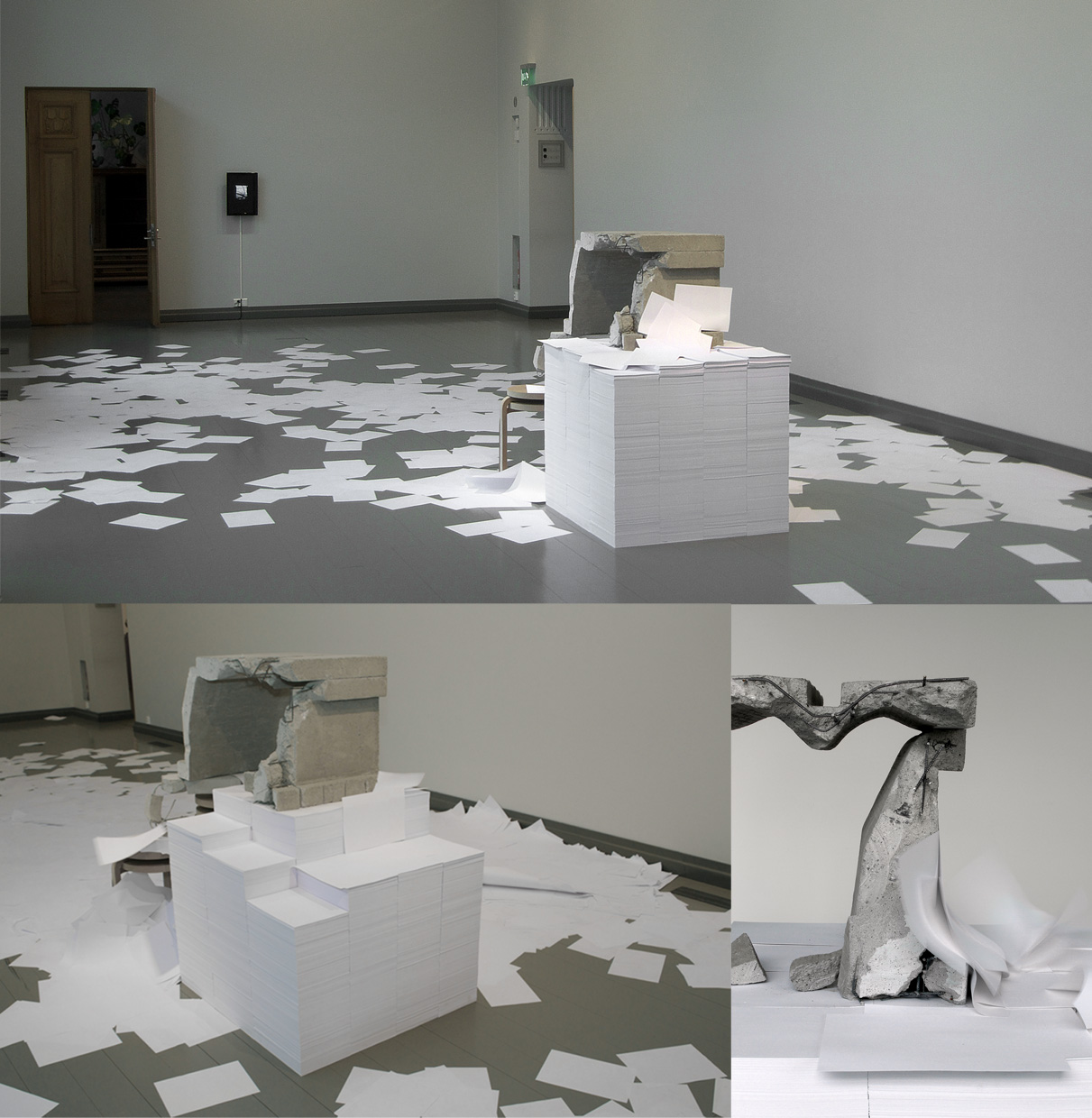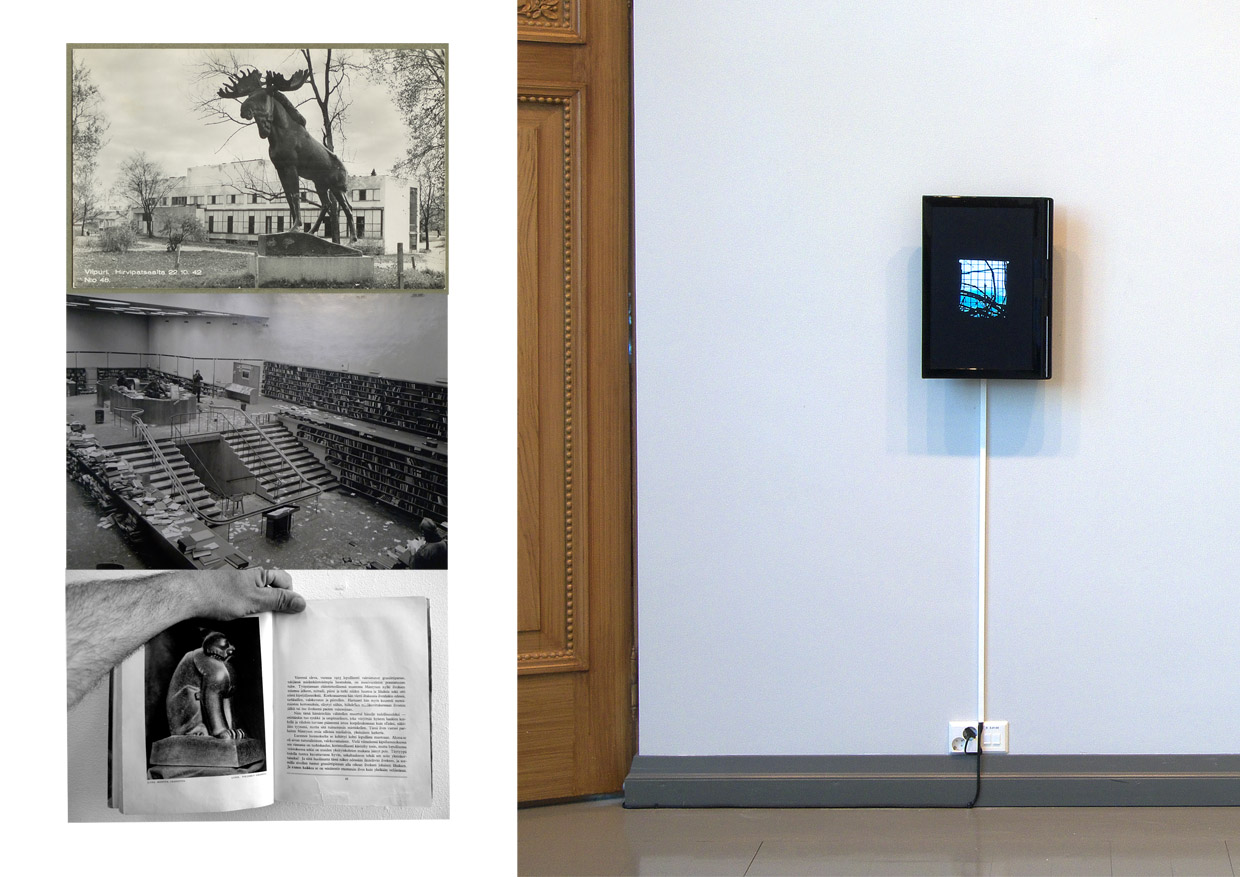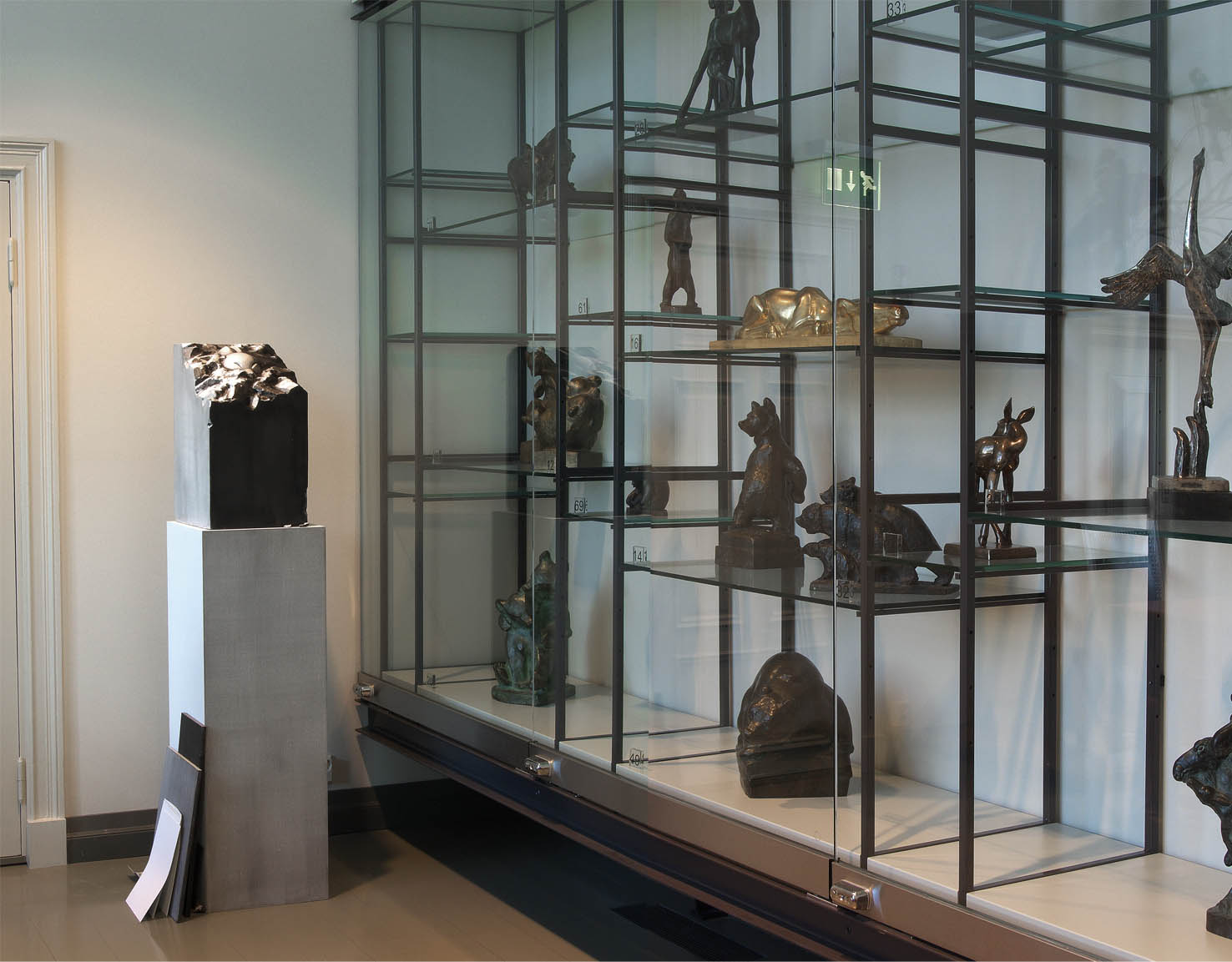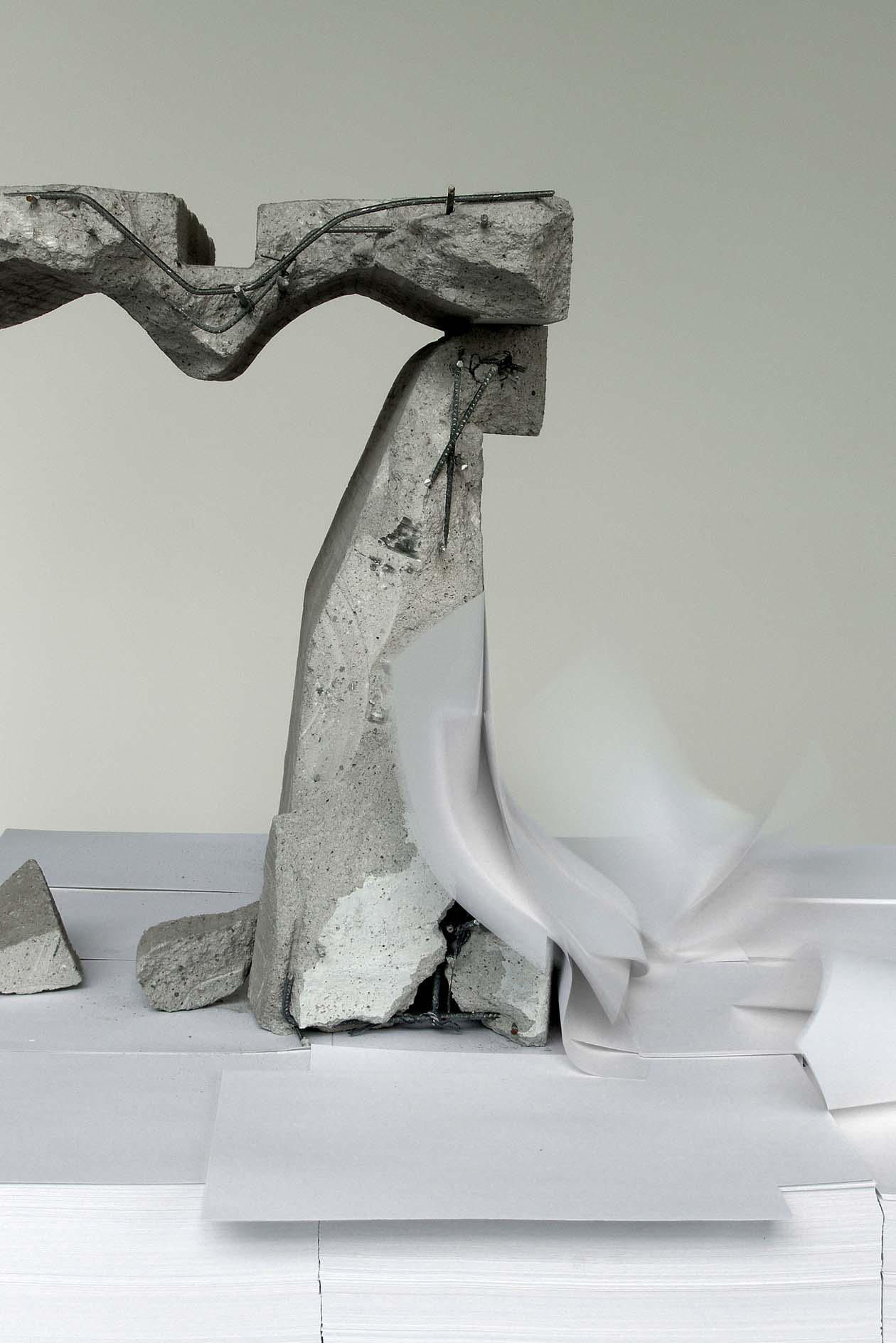Bird and Library, 2009
Turku Art Museum Studio
Installation in two rooms
Wind machine, concrete, A4 papers, MDF, video, painted foamcoat
Exhibition is consists of installation in two separate rooms.
1 st room:
In the middle of room is a cube which is made of white A4 copying paper. Behind the cube is a pile of fake Alvar Aalto stools (stool 60). Stools are made of MDF-board. Two architectonic concrete fragments lie partly on stools and partly on cube made of paper. On the end of room close to ceiling level is a wind machine. Machine is programmed so that it ocassionally blows a strong gust to the room. Air current removes papers and gradually dismantles the cube.
On the other end of the room is a 20 ” flat vertical video monitor which shows short video of jackdaw escaping from its nest.
2 nd room:
I this room ithere is permanent exhibition of Finnish animal sculptor Jussi Mäntynen (1886-1978).
Room is filled with Mäntynen’s stone and bronze sculptures. In the room there is a black and white illusionistic sculpture. Sculpture shows a fictional situation of asculpture in progress. Part of lynx's head is visible from a artificial block of stone. Block is placed on a plinth with some boards and trash leaning to it. Sculpture is made of styrofoam coverd with Foamcoat.
Installation Bird and Library is quite diverese in relation to your earlier works. It has different elements, materials and medias in one constitution. Tell me about how you construct your work. For example in this exhibition.
This work has a lot to do with Turku Art Museums collection, especially the Jussi Mäntynen collection in next room to the Studio space. Mäntynen was a former taxidermist who later devoted himself to animal sculptures. He was popular in Finland in 19 th century. His sculptures are stylized, semi modernistic sculptures and they have also a strange cartoonist exaggereting outfit. His works have strong nationalistic emphasis. His active years were the years of forming the Finland as independent state.
One is Mäntynens most famous sculptures is a Elk statue. Copys of that are located in four various towns: Viipuri (Russia), Helsinki, Lahti and Turku. While working for this exhibition I found an old poscard which depicted The Elk statue in front of Alvar Aaltos famous Viipuri library in Russia, on former Finlands area. The photo had been taken in 1942, during the truce between two wars between Finland and Sovjet Union.
Role of Alvar Aalto as “nations architect” was obvious. His international poetic modernism was regarded as a finish genuine style. The contradiction and common background between Mäntynen's heroic, mythologal sculpture and Aaltos timeless formalistic functionalism was interesting combination. Both are regarded as constructors of national esteem even they represent opposite ends in style of their production.
The exhibition took place Turku, city where Aalto had his office in beginning of century. Also the first functionalistic building in Skandinavia, Turun Sanomat printing house, is located in same town. Standard furniture, as they were called, for Viipuri Library were made in furniture factory in Turku. Viipuri Library was the first public building by Aalto where he used for eaxmple the famous three leg stools (Stool 60).
Aaltos architecture opened to me the idea of standardisation. Aalto himself didn't have clear systems, but Le corbusier’s and Aulis Blumsted’s systems are well known. I ended up using A4 paper which is maybe the most common standardised "object" we meet every day. It has tactility that is familiar to everyone. It represent also something which is bound to idea and potentiality. It gets its content by abstraction, text or drawing. A4 is sort of white cube in two dimensions. By constructing a plinth from this paper I created nothing from nothing, a platform for content.
That white cube and pile of fake stool 60s have also role as a supporter of concrete fragment. The materialMDF-board is basicly paper, it has a nature of being a non-material, material of idea. Concrete fragment has parts copied form from images of Viipuri Library, for example the outline of bird from reading rooms ceiling.
In the other end there is a wind machine. Is it just to make papers move?
When I started to do this exhibition I felt like using elements of spectacle. In the houses Aalto designed I have visited have certain modesty in them, they are intim even when they are public buildings. I wanted to include something opposite to this work. The wind machine is a machine for special effects, to create artificial naturistic effect. It has something exagerating like in Mantynenssculptures. Gusts dismante the papercube and change the exhibition situation to a temporal performance. The sculptural elements act by chance. Windmachine also takes viewer to be a part of exhibition, artificial wind disturbs them and creates a white paper floor.
The Jackdaw video is a decoy to viewer to move over the paper-covered floor. The video itself is very simple, just one image, a glipse of bird, Jackdaw escaping from its nest. Most of the time picture is empty with only black grid and branches moving in wind . Video is shooted on on handheld camera and image is in constant move. Safetynet constructs a grid over the picture. I see that as a reference to the A4 paper in the cube. Because you can see only a glimpse of the bird, viewer is obliged to wait in front of monitor for something to happen. While looking at video he is located between a wind macine and a picture of windy situation, back turned to sensation while looking at abstraction.
In the room behind the Studio space is a Jussi Mäntynen collection, a small room filled with animal sculptures. In your sculpture there is a cube on a plinth, cube is broken from the top, some round forming on the top of the cube. On the floor, leaning to plinth there are boards, papers and thrash. All this is painted black and white so that it resembles drawing or black andwhite photo. How does this work relate to Mäntynen's room?
I found an old book from 1929 where his work was presented. In the book there were profound descriptions of his devoted working methods. As a former taxidermist he knew anatomy but he also spent long times following animals in nature and zoos. He also talked to hunters to get right feeling to the work. The text created almost a fictional character of artist devoting himself to his work. Interesting was the way how written text by descriptios drew the sculptures to diffrent level. Stone sculpture of Lynx was transformed to a transcendental creature.
I made a fictional sculpture of unfinshed lynx statue. It is a picture of work in progress. Everything in sculpture is fictional: It represents situation which has not happened, it depicts materials with materials of illusion, it is painted so that it looks like flat picture. It is opposite to Mäntynens works and materials, but is by its form transsendential as original Lynx statue is by text.

